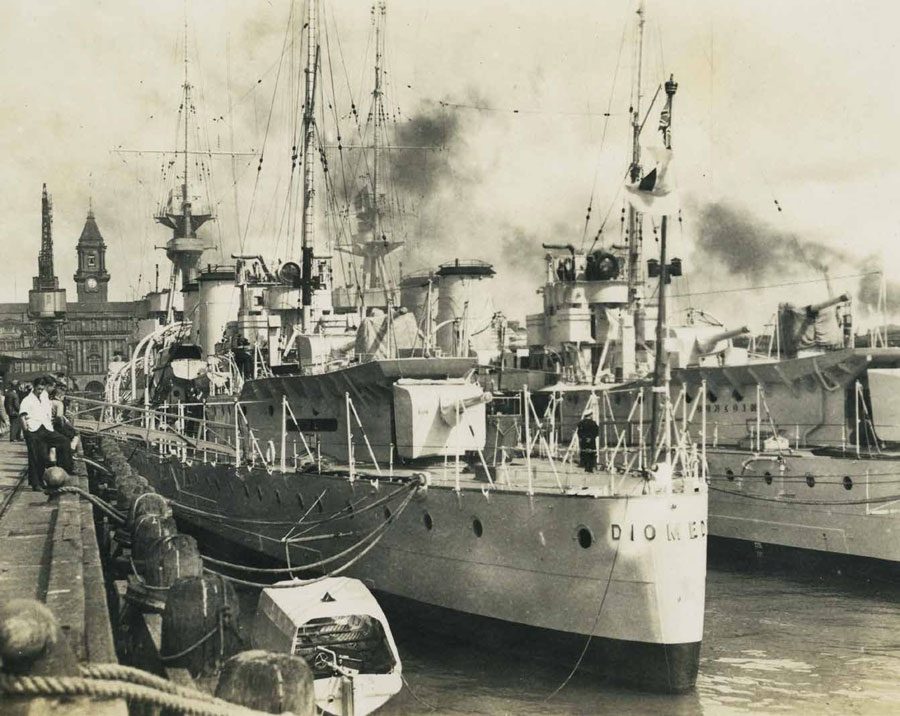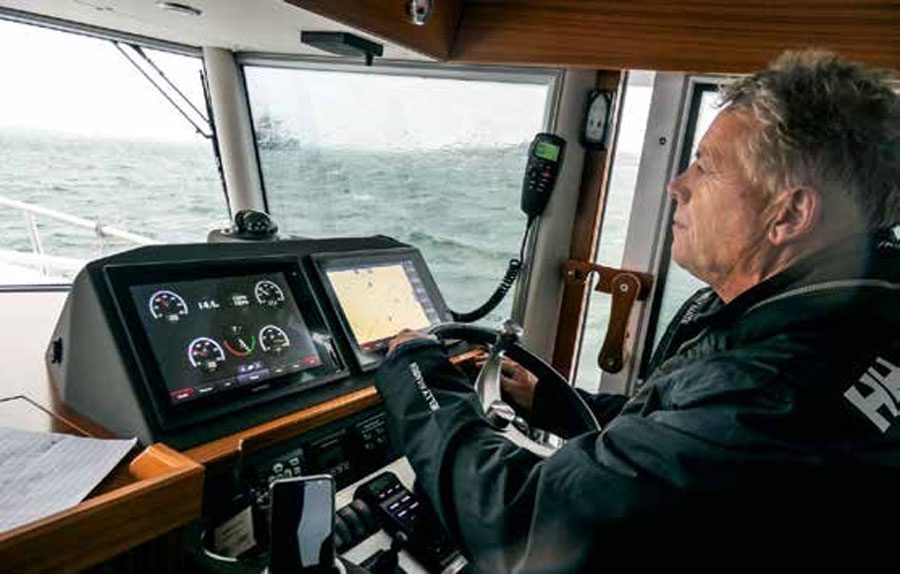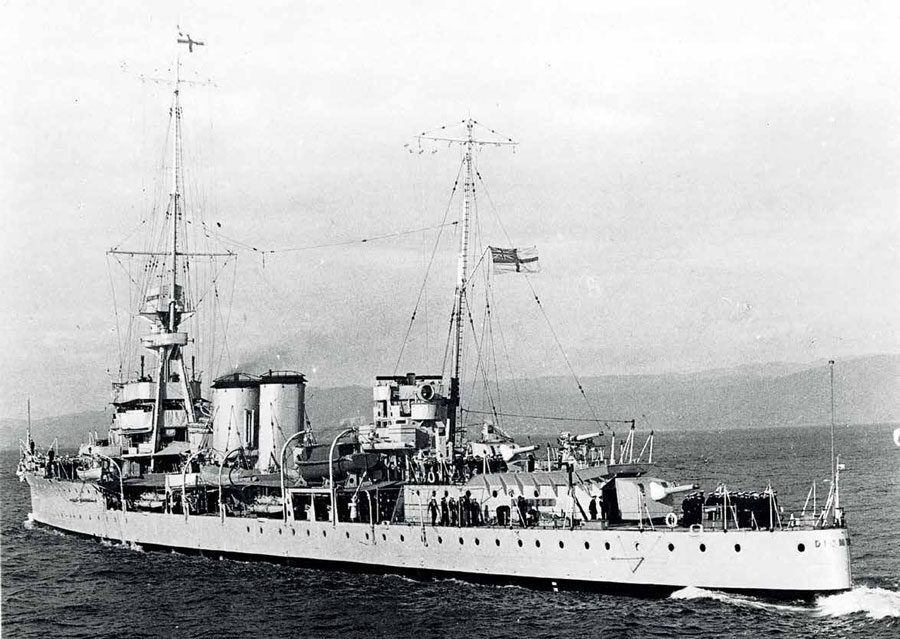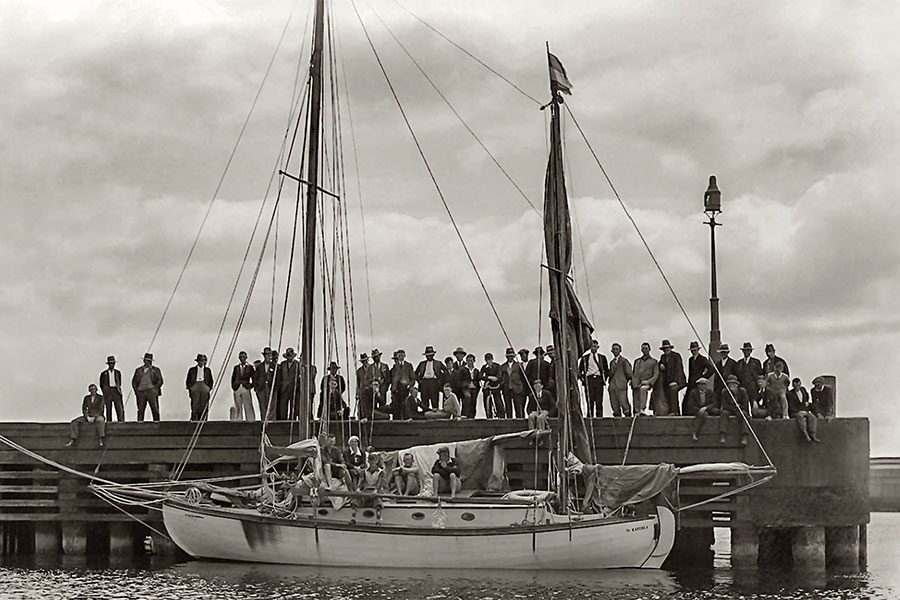

At North Head, Te Rapunga led Ngataki by half a mile and drew steadily away in the broad lead up the coast into a rising easterly. Te Rapunga last sighted Ngataki off Kawau at dark, an hour’s sail astern.
The Trans-Tasman race from Auckland to Melbourne had started at 2.46pm, Saturday 8th December 1934, from a mark off the Akarana Yacht Club’s clubhouse in Mechanics Bay. The only two contestants were German offshore yachtsman George Dibbern’s Te Rapunga and Aucklander Johnny Wray’s Ngataki, evenly matched in performance and seaworthiness. Ngataki had 17 hours’ time allowance from Te Rapunga.
When Te Rapunga was off Flat Rock about 8pm that night the yacht was making water seriously. George had never installed a bilge pump, so it was all hands to buckets. Twenty kerosene tins, 80 gallons, for every hour were needed to keep the water below the floorboards. As the yacht staggered up the coast in the easterly gale the inflow increased. They passed Bream Head at 2am on Sunday and sighted Cape Brett at 10am. When they were abeam of the Cape, about midday, the starboard mizzen rigging carried away, fortunately leaving the mast standing.
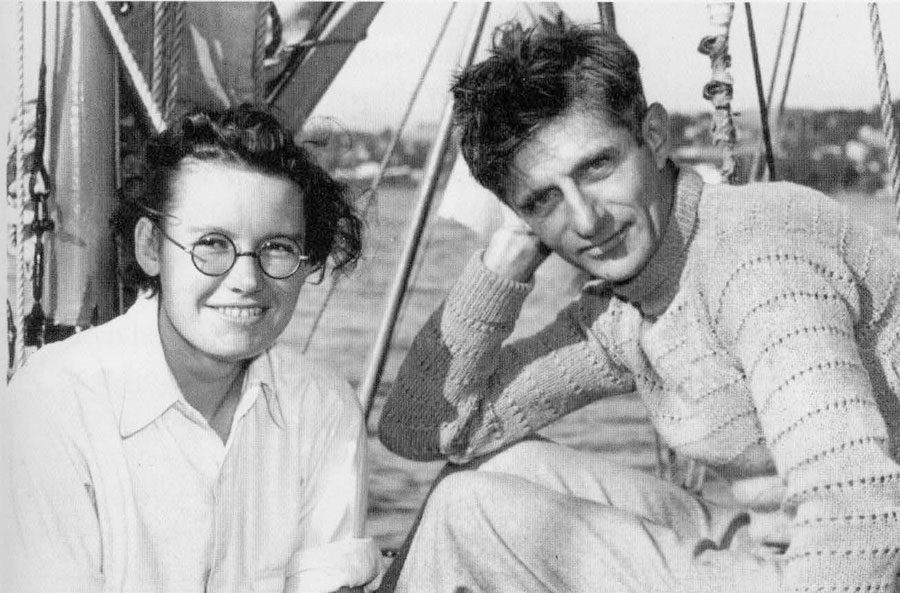 Eileen Morris and George Dibbern aboard Te Rapunga.
Eileen Morris and George Dibbern aboard Te Rapunga.
Austin Vaile, the landlubber journalist aboard, later wrote about George’s everlasting cheerfulness, his leadership, and the respect he had from his crew, the skilled seamen, George’s cousin Günter Schramm, Fred Norris and ‘Tat’, Noel Tattersfield. George took a vote. It was decided to run to Russell and round to Matauwhi Bay, to the Warne Brothers’ slip.
No single source of the leaking was found. In hindsight it was probably the result of several factors; Günter had not had time between tides, just before sailing, to fill the nail-holes after he removed the muntz metal underbody sheathing at the Devonport Yacht Club’s slip, the topsides and deck planking had shrunk in the idle time in Auckland and, as George often said, her oak planking, while ideal for the Baltic, was unsuitable for ocean cruising in the tropics as it moved too much.
Leon Warne and the crew set to work re-caulking the hull and repairing the rigging, but 44 hours were lost before they could set off in pursuit of Johnny Wray. George was convinced that he was trailing Ngataki. By the time both yachts were in the vicinity of Cape Maria van Diemen the weather was light and foggy from the north. The lighthouse keeper saw neither yacht.
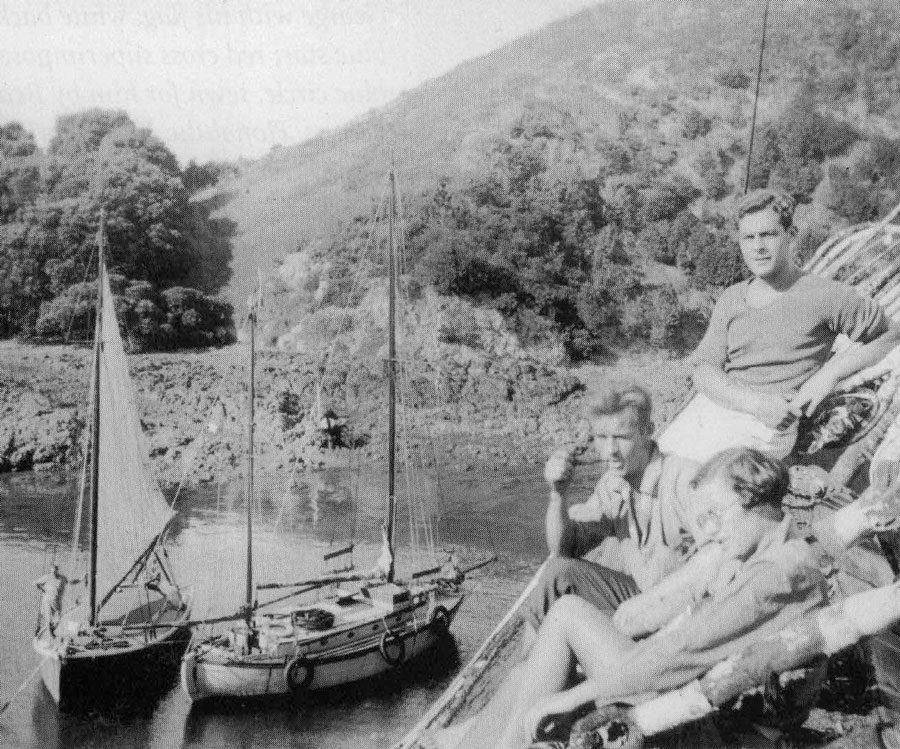 Te Rapunga in the lee of Rewa at Moturekareka at the start of the voyage to the Pacific August 1935. Eileen Morris foreground.
Te Rapunga in the lee of Rewa at Moturekareka at the start of the voyage to the Pacific August 1935. Eileen Morris foreground.
In fact, a comparison of logs showed both yachts had passed outside the Three Kings on 13th December, Ngataki just 50 miles ahead, and set a course for Bass Strait. Te Rapunga had a particularly good run, in good sailing weather. On December 27 she crossed the Heads into Port Phillip and, at 5pm, got to the finish line at the Gellibrand lightship at Williamstown. The welcoming yachts pointed out that she had finished on the wrong side, the westward side. George re-read the rules and re-crossed the line on the east, losing 27 minutes in the process. George’s first question was about Ngataki which he was expecting to be ahead of them owing to their delays at Matauwhi Bay.
Te Rapunga’s elapsed time for the 1,630 miles was 19 days 2 hours, an average speed of four knots when she was at sea. The steamer Kalingo had sighted Ngataki early on December 26 near Bass Strait about 240 miles from Port Phillip, making a good 10 knots in a strong easterly and rough seas, not far behind Te Rapunga. The clock was ticking.
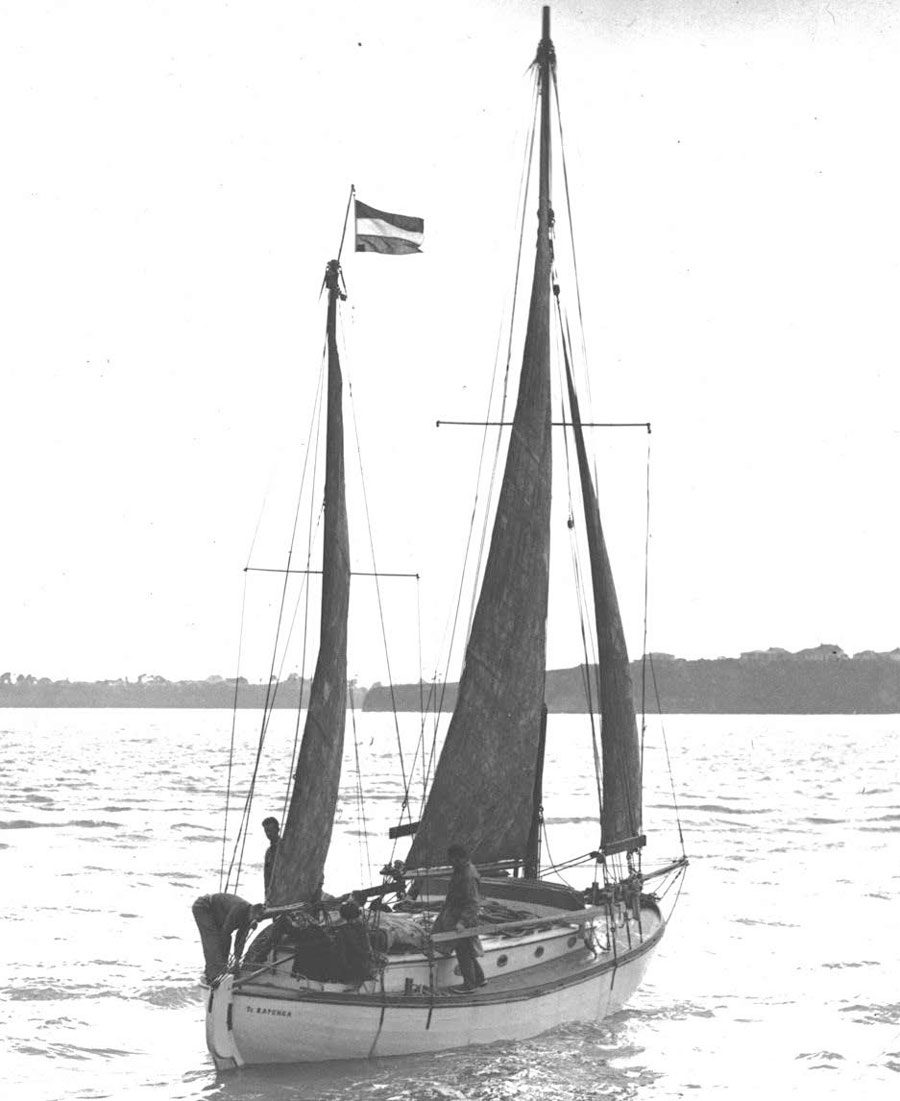 Te Rapunga departing Auckland, August 18 1935.
Te Rapunga departing Auckland, August 18 1935.
Te Rapunga got a great reception from the Royal St. Kilda and Brighton Yacht Clubs while they anxiously awaited Ngataki. At the same time the Centenary Bass Strait race finishers, Oimara, Phyllis, Thistle and Shamrock, were also trickling into Melbourne and mooring together at St. Kilda.
On December 28 Ngataki was seen off Port Lonsdale flying the yellow flag past the quarantine station at Portsea at 6.30pm and left there for Williamstown, crossing the line 28 hours after Te Rapunga. With her handicap of 17 hours, she was just 11 hours short of winning. Te Rapunga was awarded the Trans- Tasman Cup presented by the Akarana Yacht Club, worth £50, and £70 presented by the Victorian Yachting Association.
Once ashore together, the crews proposed a race back to New Plymouth. A cablegram to the mayor asking for consideration (and prize money) drew a negative response in those hard Slump times. Then Austin Vaile arranged a race to Hobart supported by the Royal Hobart Regatta Commission with a first prize of £20 and a second of £10 in connection with its annual regatta on February 5, 1935. Ngataki had 12 hours’ handicap for the 460- mile voyage. Fred Norris had returned to Auckland by steamer. Te Rapunga’s crew were Günter, Noel Tattersfield, Austin Vaile (now a blooded ocean voyager) but added Betty Roehr, the wife of a friendly café proprietor in Russell Street for the trip.
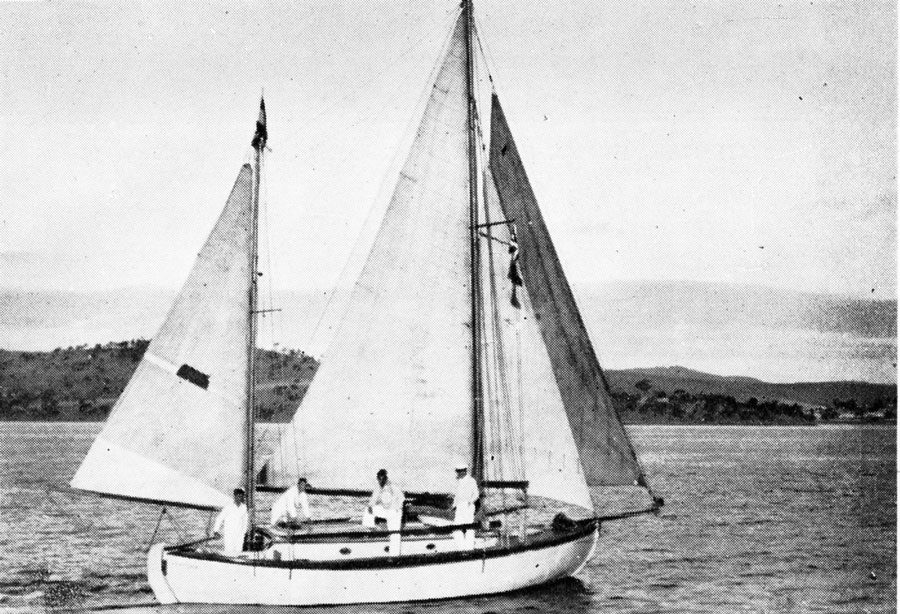 Te Rapunga racing in a regatta on the Derwent, February 1935, the crew in whites.
Te Rapunga racing in a regatta on the Derwent, February 1935, the crew in whites.
The race started from the St. Kilda pier in the afternoon of 22nd January. There was a Le Mans-type start. The crews first drank a schooner of beer at the Royal St. Kilda Yacht Club’s bar then ran the 100 yards to the long pier to set sails and cast off. From Noel Tattersfield’s diary:
“Ngataki’s crew had everything in readiness for leaving, with dinghy lashed on, deck and the sails ready for hoisting. Te Rapunga’s crew got their tender aboard and started to hoist the sails when it was noticed that Schramm was missing. He soon showed up, however, sprinting along the pier as best he was able, handicapped by a large sack containing bottled liquids usually included in a yacht’s stores. He was not long aboard before the sudden release of the main sheet, when he was heaving on the topping lift, caused him to fall overboard. As Te Rapunga cleared St. Kilda pier she pitched suddenly in a big sea, and Schramm took another header into the water. He just climbed aboard again, and there were no more cases of ‘man overboard’ during the voyage. Schramm’s antics were loudly cheered, by the large crowd on the pier which watched the departure of the yachts.”
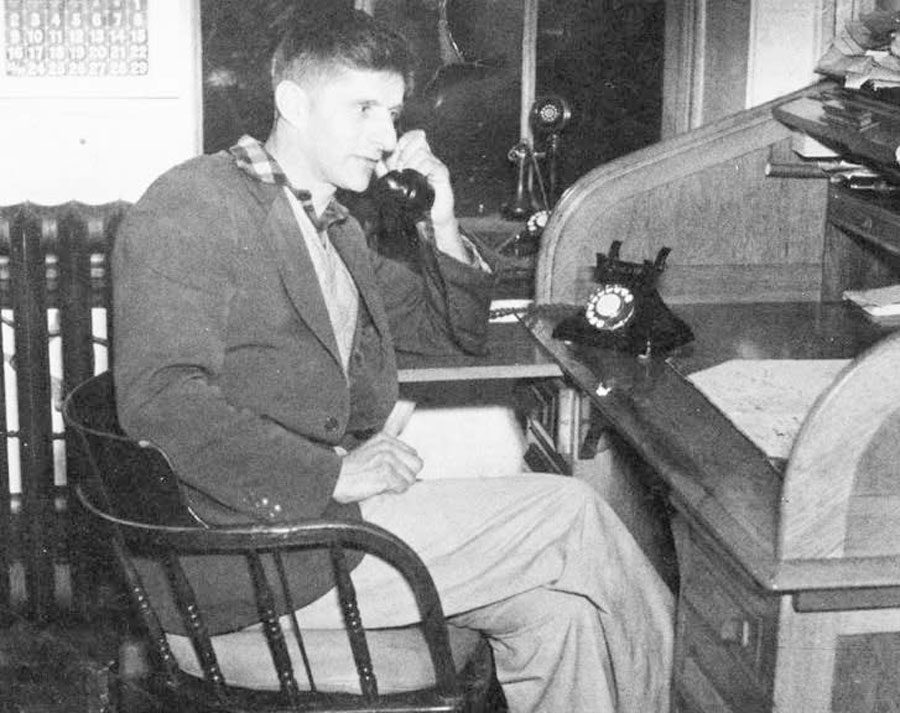 George Dibbern phoning his wife in Germany July 11, 1935.
George Dibbern phoning his wife in Germany July 11, 1935.
Outside the Heads there was a strong northwester and rough seas. Te Rapunga came in first in five days, six hours, berthing in Hobart at 2am by the headlights of cars on the wharf. Ngataki came in 84 hours later after a violent passage in which her mainsail was blown out and her dinghy was smashed to smithereens in the by now westerly gale.
Rested and recovered, the two yachts took part in the Hobart and Bellerive Regattas on the Derwent and gave talks on the radio and at the yacht clubs. They tried to get sponsorship for a race to Bluff and up the east coast to Auckland. Nothing came of that, so on February 27, 1935, Ngataki left for Auckland via North Cape and Te Rapunga, on March 5, for Bluff with a crew of three, George, Günter and Noel. They reached Bluff after a quick passage on March 15. George’s crew had sighted the coast six days before but struck fog and light winds. Te Rapunga sailed for Auckland via Napier and Gisborne two days later after a massive feast of Bluff oysters. Ngataki arrived at Russell on March 20 en route to Auckland after an uneventful crossing but punching into headwinds.
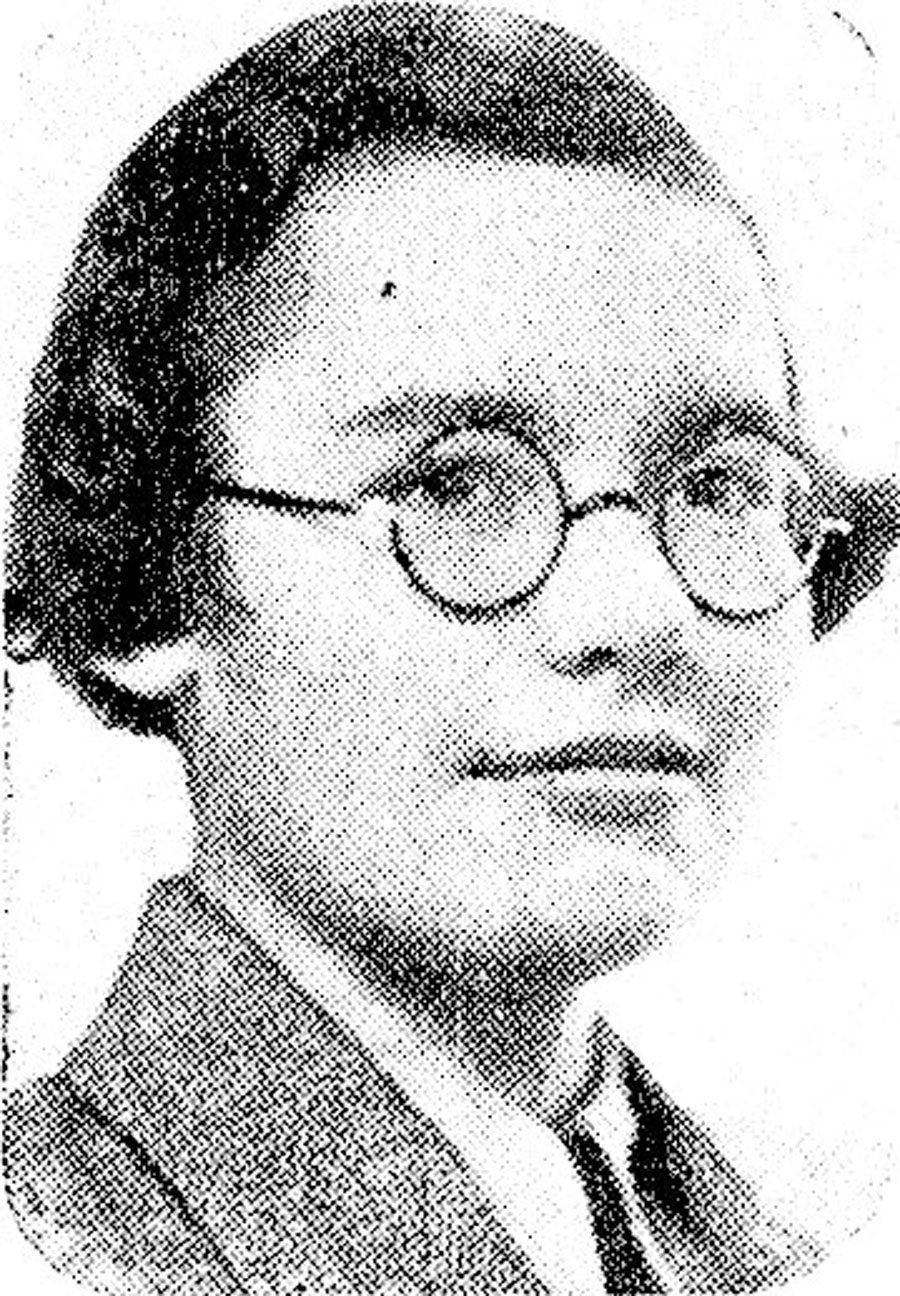 A press photo of Eileen Morris.
A press photo of Eileen Morris.
Te Rapunga called at Napier for George to see his old Hawkes Bay friends. Günter left the yacht to marry a local girl and take up farming in Tasmania. Eileen Morris came aboard to visit and was persuaded to crew “just to Gisborne” but went on to Auckland to the chagrin of her mother. Noel left for Auckland from Gisborne where Maurice Black and journalist Roy Murdock joined; on to Auckland by way of Port Fitzroy to shelter, arriving on April 21, 1935.
A cheery breath of fresh air in those troubled economic and political times, George had huge press coverage, but Eileen Morris’ place aboard was the real hot topic and was fostered by coy stories about her in the daily newspapers, the N.Z. Truth and the Woman’s Weekly, a typical quote:
“When interviewed, Miss Morris said ‘I thought it over very carefully, realising that by taking the trip I would be breaking away from established conventions, but I am convinced that for an individual under certain circumstances to allow himself or herself to be cramped by the narrow bounds of convention is both unnecessary and foolish.”
 Te Rapunga finishing the Trans-Tasman at Williamstown.
Te Rapunga finishing the Trans-Tasman at Williamstown.
This was an expression of George’s philosophy, later expressed powerfully in his book Quest, which Eileen was to start typing on board.
George hit the headlines again when he made a radiotelephone call to his wife Elisabeth in Germany from the Wellesley Street Post Office on the evening of July 11, a novel technical achievement for the time.
Maurice Black of Gisborne joined the crew. Te Rapunga left Auckland on August 18, 1935 for a fortnight’s cruise of the Hauraki Gulf, calling on Charlie Hanson on Moturekareka Island, to lie in the lee of the wreck of the barque Rewa and on to Great Barrier, before heading for Rarotonga on September 11 on “a three years’ cruise of the world.”
I will pick up the intriguing story of George Dibbern, Eileen Morris and Te Rapunga in later articles. BNZ


